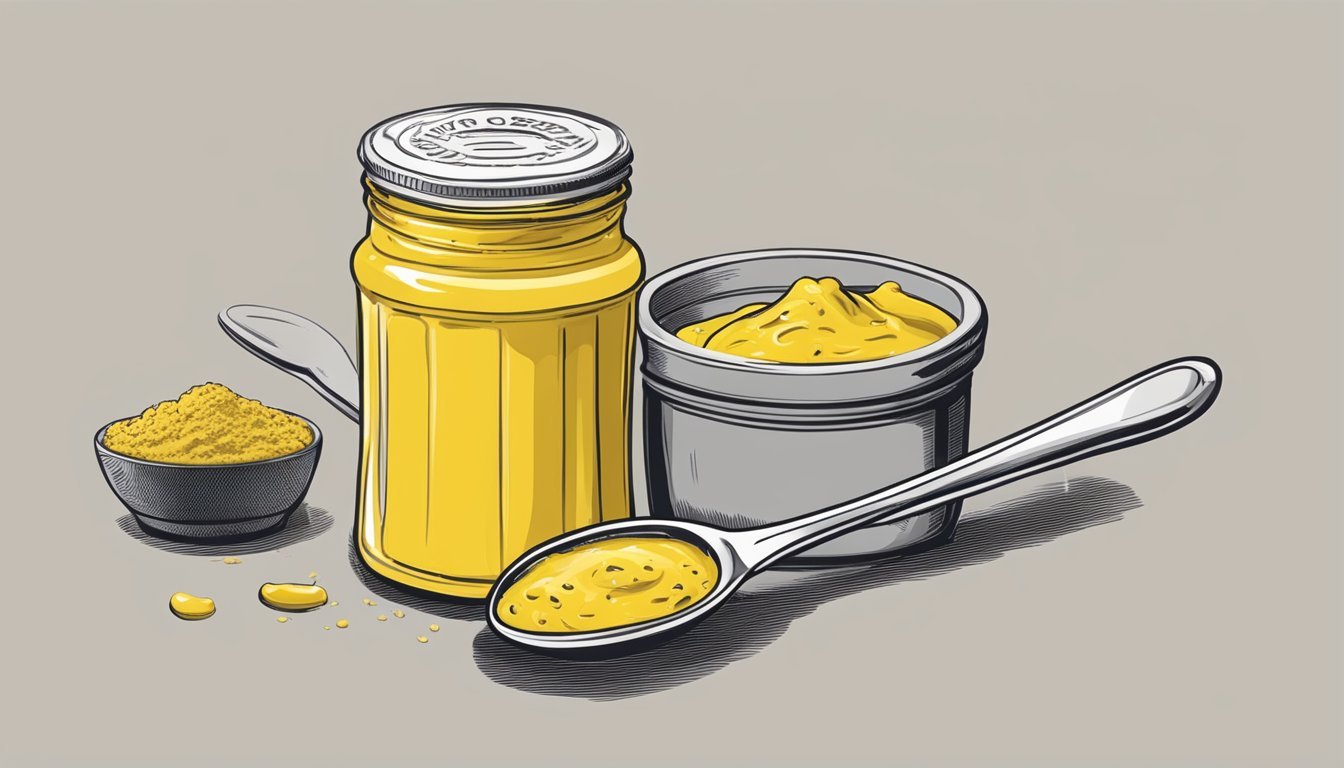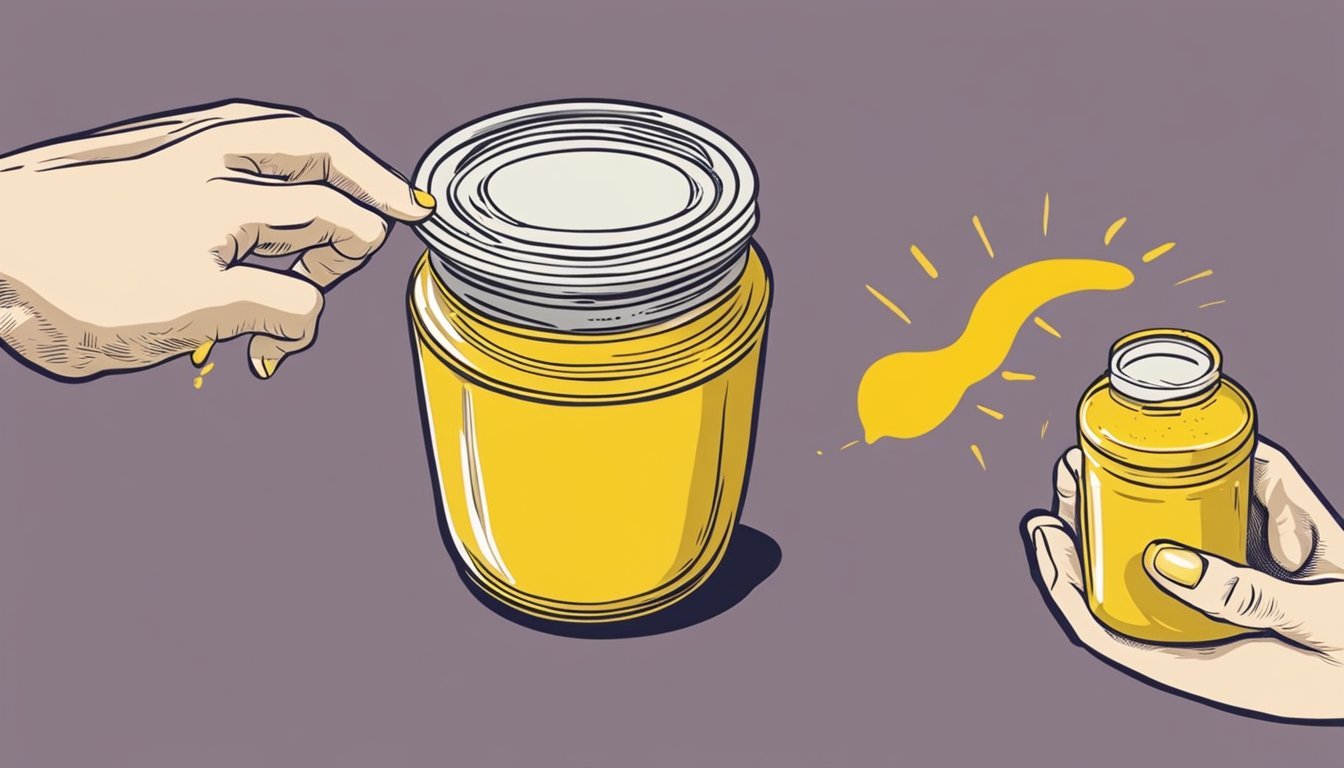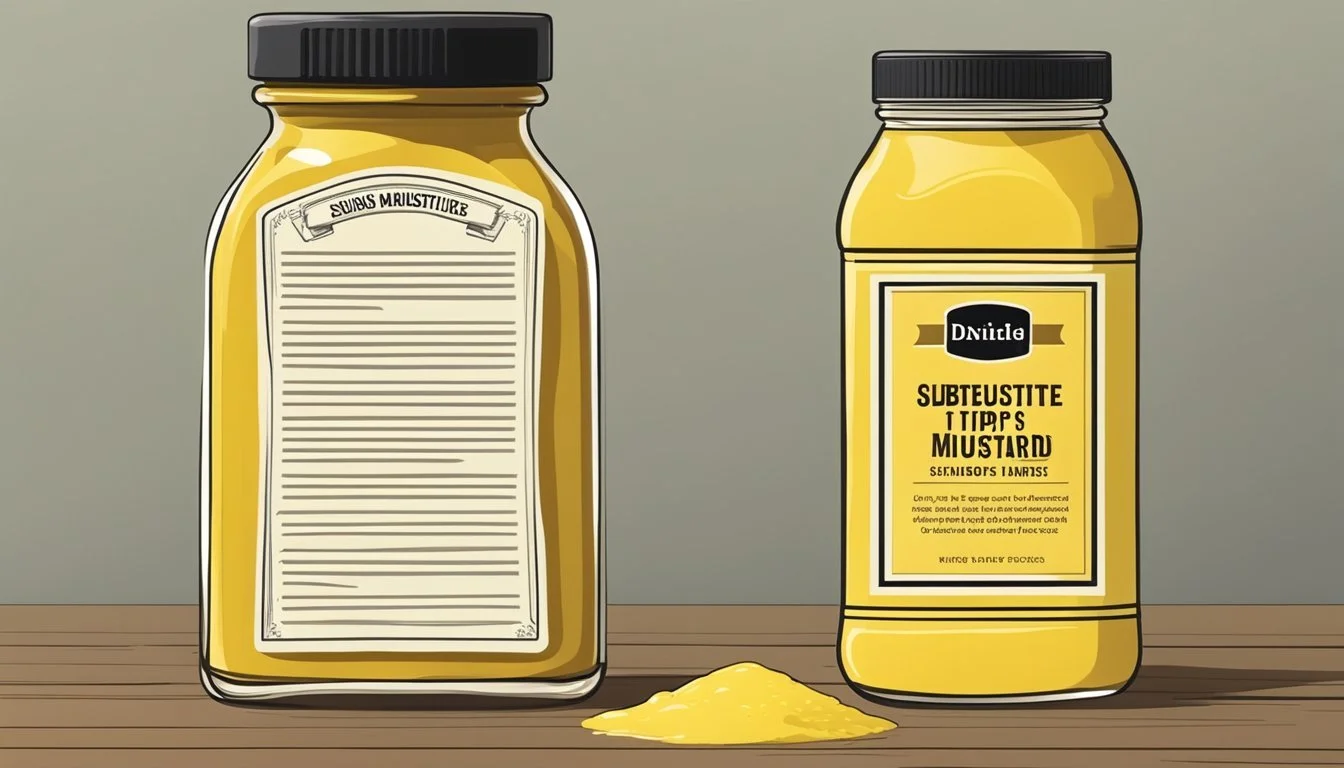How to Substitute Dijon Mustard for Yellow Mustard
A Simple Swap Guide
When a recipe calls for Dijon mustard, but all that's available in the pantry is yellow mustard, it's not the end of the world. Yellow mustard, milder in flavor compared to its Dijon counterpart, can replace Dijon mustard effectively in most recipes. The key is understanding the flavor profile and texture differences between the two mustards to ensure the substitute does not disrupt the dish's intended taste and consistency.
Yellow mustard is typically brighter and less complex than Dijon mustard, which has a distinctive sharp and tangy flavor. When substituting yellow mustard for Dijon, cooks may need to adjust other ingredients to achieve the desired depth and richness the recipe intends. A simple one-to-one substitution often works, but slight alterations could provide a closer match to Dijon's unique qualities.
In culinary practices, mustard is a versatile condiment and ingredient, and knowing how to substitute different types of mustard can be invaluable. Whether the dish is a vinaigrette, marinade, or glaze, replacing Dijon mustard with yellow mustard is straightforward if one considers the dish's flavor balance and desired outcome. This technique enables the continuity of cooking, even when specific ingredients are absent.
Understanding Mustard Varieties
Mustards come in various forms, each with distinct flavors and ingredients, offering an array of uses from marinades to classic hot dog toppings. Within this variety, two particularly notable forms are Dijon and yellow mustard, which are often used interchangeably though they bear intrinsic differences.
Traits of Dijon Mustard
Dijon mustard originates from the city of Dijon in France and is known for its tangy, sharp, and slightly spicy flavor. Key ingredients typically include:
Brown mustard seeds
White wine vinegar or a combination of water and wine
Salt
Spices (which may vary)
Dijon's flavor profile is more complex than yellow mustard and is less acidic, with a smoother texture often used in emulsifying salad dressings or as a base in sophisticated marinades.
Characteristics of Yellow Mustard
Yellow mustard, commonly known as American mustard, is milder compared to Dijon and is brighter in color. It is characterized by:
White mustard seeds
Turmeric (which gives it the yellow color)
Mild vinegar (such as distilled vinegar)
Water
Salt
Optional sweeteners or spices
This type of mustard is a staple condiment for hot dogs, with a flavor profile that's more acidic and a texture that's more watery.
Other Mustard Types
Aside from Dijon and yellow mustards, other varieties include:
Spicy Brown Mustard: Made with brown mustard seeds, less vinegar, and a blend of spices, giving it a robust and spicy flavor suitable for sandwiches and sausages.
Honey Mustard: A blend of honey with mustard (which can be Dijon, yellow, or a mix), creating a sweet and tangy condiment popular in dressings and glazes.
Stone-Ground Mustard: This rustic variety features partially ground brown mustard seeds, often combined with vinegar and spices, resulting in a coarser texture and a spicier flavor than yellow mustard but milder than Dijon.
Whole-Grain Mustard: It boasts whole or cracked mustard seeds, providing a grainy texture and a pungent flavor. It's frequently used to top meats or to mix into vinaigrettes.
These different mustards can bring unique elements to recipes, and understanding their distinctiveness is beneficial when considering substitutions.
Why Substitute Mustard?
The reasons for substituting mustard typically center on fulfilling specific recipe parameters, aligning with personal taste preferences, managing nutritional content, and compensating for availability concerns.
Recipe Requirements
Recipes often call for a specific type of mustard to achieve a desired flavor and texture. Dijon mustard is known for its tangy, sharp flavor and creamy consistency. When a recipe specifies Dijon mustard but only yellow mustard is on hand, the cook may need to substitute due to the lack of the specified ingredient. The texture and flavor of the dish may vary slightly with the substitution.
Personal Taste Preferences
Personal preference plays a significant role in choosing ingredients. Some individuals may find the robust taste of Dijon mustard too strong and prefer the milder and less pungent flavor of yellow mustard. Conversely, a person might enjoy a more prominent mustard flavor in their dishes, prompting them to find an alternative to the milder yellow mustard.
Nutritional Considerations
Nutrition can dictate the choice between Dijon and yellow mustard. One might compare their calorie, sodium, and carbohydrate content:
Calories: Dijon mustard typically contains slightly more calories.
Sodium: Yellow mustard often has a higher sodium content.
Carbohydrates: Dijon mustard can have marginally more carbohydrates.
Different types of mustard may impact the nutritional profile of a dish, making this a thoughtful consideration for health-conscious individuals or those with dietary restrictions.
Availability and Accessibility
Accessibility is another reason to substitute mustards. Not all grocery stores carry a wide variety of mustard types. Dijon mustard may not be available, requiring a cook to use yellow mustard instead. This can be a common issue in regions where Dijon is not a standard pantry item, leaving cooks to adapt with what is readily accessible.
Culinary Implications of Substituting Mustard
When substituting Dijon mustard with yellow mustard in a recipe, a chef must consider how this swap will affect the dish's flavor, consistency, and suitability within specific cooking techniques and traditional culinary practices.
Flavor Impact
The primary difference between Dijon and yellow mustard is flavor intensity and complexity. Dijon mustard, made with brown mustard seeds, boasts a strong, sharp taste and a touch of wine or vinegar, often elevating the profiles of burgers, salad dressings, and marinades. Yellow mustard, typically milder due to the use of white mustard seeds, may require additional ingredients to match Dijon's pungency, such as a hint of horseradish or wasabi.
Dijon Mustard: Strong, sharp, complex
Yellow Mustard: Milder, less complex
Substitutions: Adjust with horseradish or wasabi to mimic Dijon's intensity
Consistency and Texture Effects
Dijon mustard usually imparts a smooth and creamier texture to dishes. In contrast, yellow mustard might introduce a slightly more watery consistency due to its different formulation. This can notably affect emulsified dishes like salad dressings where the mustard's role is to blend oil and vinegar seamlessly. Using yellow mustard as a substitute may necessitate slight modifications, like reducing added liquids or adjusting emulsification techniques.
Dijon Mustard: Creamy texture
Yellow Mustard: Potentially more watery
Adjustments: Reduce other liquids; tweak emulsification if necessary
Cooking Techniques
Each mustard type responds to heat and cooking methods differently. While Dijon mustard often withstands the cooking process well, retaining its flavor profile in heated dishes like marinades for meats, yellow mustard's flavor can become subdued when cooked. It's crucial to account for this variance in dishes where mustard is a key ingredient.
Dijon Mustard: Flavor holds up under heat
Yellow Mustard: Flavor may diminish when cooked
Cultural and Traditional Aspects
Traditionally, Dijon mustard is pivotal in French cuisine, while American cooking extensively features yellow mustard, particularly in casual dining scenarios like burgers. Substituting Dijon with yellow mustard could influence the authenticity of culturally rooted recipes, and chefs might have to balance tradition with the available ingredients and desired outcomes in the dish.
Dijon Mustard: Essential in French cuisine
Yellow Mustard: Staple in American fare
Consideration: Maintain authenticity vs. ingredient availability
Selecting a Suitable Substitute
When substituting Dijon mustard for yellow mustard, it's important to consider taste, mustard seed type, and alternative ingredients to match the desired flavor profile and texture in recipes.
Taste Comparisons
Dijon Mustard presents a complex, sharp flavor with a touch of wine-like tang, courtesy of white wine or a similar acidic component in its composition. Yellow Mustard is milder, less spicy, and slightly sweeter, often colored with turmeric which also adds subtle earthy tones. Substitutes like Spicy Brown Mustard or Stone Ground Mustard are closer in flavor to Dijon, being spicier than Yellow Mustard, while Honey Mustard adds a pronounced sweetness. For heat without the tang, Horseradish or Wasabi can adjust the kick of Yellow Mustard to better mimic Dijon's sharpness.
Mustard Seed Types
The type of mustard seed used greatly influences the flavor and heat level of the mustard. Yellow Mustard typically uses white mustard seeds, which are milder. In contrast, Dijon Mustard often features brown mustard seeds, resulting in a hotter and more pungent flavor. Substitutes such as Spicy Brown Mustard and Stone Ground Mustard also incorporate brown or a mix of brown and black mustard seeds, hence being suitable for their robust taste.
Alternative Ingredients Examined
For those looking to replicate Dijon Mustard's flavor in the absence of mustard, combining ingredients like Mayonnaise with a small amount of Oil, Vinegar, and perhaps a pinch of Turmeric can approximate its creaminess and tang. For non-mayo options, blending Sauces or condiments with similar acidic and spicy profiles can serve as make-shift substitutes. It's essential to consider the flavor balance of the recipe when choosing an alternative, to ensure the substitute complements the dish effectively.
How to Substitute Dijon for Yellow Mustard
When a recipe calls for Dijon mustard and it's not available, yellow mustard can be used as a substitute while maintaining flavor and consistency with a few adjustments.
Direct Substitution Ratios
For most recipes, Dijon mustard can be replaced with yellow mustard in 1:1 ratio. Yellow mustard, which is milder, can be directly swapped for the sharper taste of Dijon without altering the amount.
Making Adjustments for Taste and Consistency
After substituting yellow mustard for Dijon, it might be necessary to adjust for taste and consistency:
Vinegar: Add a splash if a tangier flavor is desired to mimic Dijon's acidity.
Spices: Incorporate a pinch of spices such as garlic powder or onion powder to add depth.
Creamy Consistency: For a creamier texture in dressings, mix in a small amount of sour cream or mayonnaise.
Homemade Dijon Mustard Alternatives
Creating a homemade alternative to Dijon mustard includes combining:
Dry Mustard: Start with dry mustard as a base.
Vinegar: Add white wine vinegar to replicate the sharpness.
Spices & Seasonings: Mix in a pinch of salt and a small amount of sugar to balance the flavors.
Oil: Incorporate a teaspoon of oil for a smoother consistency.
A simple table to outline a basic homemade Dijon mustard substitute:
Ingredient Quantity Dry Mustard 1 tbsp White Wine Vinegar 2 tsp Salt 1/4 tsp Sugar A pinch Oil 1 tsp
For salad dressings or marinades, where Dijon mustard is a key ingredient, these homemade alternatives can effectively maintain the desired flavor profile.
Practical Applications and Recipe Ideas
When substituting Dijon mustard for yellow mustard, one should be mindful of the differences in flavor intensity and acidity. The substitutions within recipes need to be precise to maintain the desired taste and texture.
Vinaigrettes and Salad Dressings
Yellow mustard can be used in vinaigrettes and salad dressings as a 1:1 substitute for Dijon mustard. The milder flavor of yellow mustard is less pronounced than the tangy and spicy profile of Dijon. When preparing dressings, consider adjusting the quantity of vinegar in the recipe as yellow mustard typically contains a higher amount of vinegar, which might affect the dressing's acidity.
Ingredient Dijon Mustard Yellow Mustard Vinegar Amount 1 Part 1 Part (with consideration for flavor) Adjust as needed
Marinades and Glazes
For marinades and glazes that call for Dijon mustard, yellow mustard can also be substituted in equal measure. While Dijon offers a depth of flavor to marinades, especially for meats like roast beef, yellow mustard may result in a slightly tangier and less complex flavor profile. If the recipe requires additional tanginess, a splash of extra vinegar may be omitted.
Classic Sandwiches and Burgers
Substituting Dijon with yellow mustard in sandwiches and burgers can alter the sophistication of the flavor. Yellow mustard provides a more straightforward tanginess, whereas Dijon mustard offers a complex zesty and sharp flavor. For classic applications like deviled eggs, yellow mustard imparts a traditional touch, while Dijon might be used for a more refined taste.
Specialty Dishes
Specific dishes that traditionally use Dijon mustard, such as in sauces for roast beef, may change substantially in flavor when opting for yellow mustard. These alterations might not always align with the expected flavor profile. It’s advised to be cautious with the quantity and to possibly reduce the amount of yellow mustard in recipes where Dijon's spiciness is key to the dish.
Health and Nutritional Information
When substituting Dijon mustard for yellow mustard, it is useful for readers to understand the health and nutritional differences between the two condiments. These differences can impact dietary choices and nutritional balance.
Caloric and Sodium Content
Dijon Mustard:
Calories: On average, Dijon mustard contains approximately 5 calories per teaspoon.
Sodium: Typically, it has about 120mg of sodium per teaspoon.
Yellow Mustard:
Calories: Yellow mustard usually contains around 3 calories per teaspoon.
Sodium: This variety often has about 57mg of sodium per teaspoon.
The specific caloric and sodium content can vary depending on the brand and formulation.
Considerations for Dietary Restrictions
Mustard Seeds:
Both Dijon and yellow mustards are made from mustard seeds; Dijon often uses brown seeds, while yellow usually utilizes white seeds.
Vinegar:
Vinegar is a common ingredient in both types of mustard, contributing to their respective flavors and acidity profiles.
Ingredients:
Additional ingredients in Dijon mustard can include white wine, which may not be suitable for all dietary restrictions. Conversely, yellow mustard typically includes turmeric, giving it its distinctive color.
Manufacturer:
Consumers should consider the specific manufacturer's product formulations, as they can vary significantly in terms of additional ingredients and the potential presence of allergens.
Readers with dietary restrictions should check the labels for specifics, as manufacturers might add other ingredients that could affect dietary conditions, such as gluten sensitivity or the presence of animal-derived ingredients.
Shopping Tips for Mustard Substitutes
When looking for mustard substitutes at the grocery store, it's essential to consider taste preferences and ingredient quality. Mustard alternatives range from mild to spicy, impacting the final flavor of your dish. Here's how to make informed choices while shopping.
Identifying Quality Substitutes
When shopping for a Dijon mustard substitute, the goal is to find an option that closely resembles its tangy and slightly spicy profile. Stone ground mustard, which contains a similar brown mustard seed base, can provide a comparable taste with added texture. For a milder flavor, yellow mustard is a readily available alternative, though it lacks the depth of Dijon. Personal preference plays a significant role, so one might also consider honey mustard for a sweeter twist.
Reading Labels for Ingredients and Allergens
The label on a mustard jar holds vital information about its content. Customers should scrutinize the ingredients list for quality — the fewer additives, the better. For example, a high-quality stone ground mustard might list brown mustard seeds, vinegar, water, and salt with no added preservatives. It's also prudent to check for allergens; some mustards may include ingredients like wine or honey, which could be relevant for dietary restrictions.
Storing and Shelf Life
Mustard substitutes have varying shelf lives, and proper storage is key to maintaining their quality. Most mustard jars will indicate the best storage conditions, usually in a cool and dry place. Once opened, mustards should be refrigerated to extend their shelf life. As a rule of thumb, consumers can expect an unopened jar of mustard to last about 2-3 years from the manufacturing date, while an opened jar should be used within a year for optimal flavor.
Frequently Asked Questions
This section addresses common inquiries regarding the substitution of Dijon mustard for yellow mustard, how to adjust recipes accordingly, and explores various alternatives to Dijon mustard.
Mustard Substitute FAQs
Can one use yellow mustard as a direct substitute for Dijon mustard?
Yes, yellow mustard can replace Dijon mustard in recipes. It should be noted that yellow mustard is milder, so the flavor intensity may need to be increased to match that of Dijon.
What are the main considerations when substituting mustards?
Primarily, one should consider the flavor and consistency differences. Yellow mustard often has a more tangy, less spicy flavor, and its consistency is smoother compared to the coarse texture of some Dijon mustards.
Recipe Adjustments FAQs
How do recipe proportions change when substituting yellow mustard for Dijon?
When substituting, start with a one-to-one ratio, then adjust to taste. Be cautious of the recipe's balance since the sharper taste of Dijon could become subdued.
Are any additional ingredients needed to mimic Dijon's properties?
To replicate Dijon’s distinct flavor, add a pinch of seasonings if necessary. Common add-ins include a small amount of horseradish or wasabi for heat, or a touch of honey for sweetness.
Dijon Mustard Alternatives FAQs
What are some suitable alternatives for Dijon mustard in recipes?
Alternatives include:
Stone ground mustard: This variety can offer a similar spicy kick.
Mayonnaise: In dressings and emulsifications, mayonnaise can provide a creamy consistency, although it lacks the mustard flavor.
A homemade mix: Combine mustard seeds, vinegar, and optional spices to create an approximation of Dijon mustard’s flavor.
How does one make a Dijon mustard substitute from scratch?
To make a homemade substitute, soak mustard seeds in vinegar and water, let it sit for up to 2 days, then blend to the desired consistency. Adjust spices to taste.








